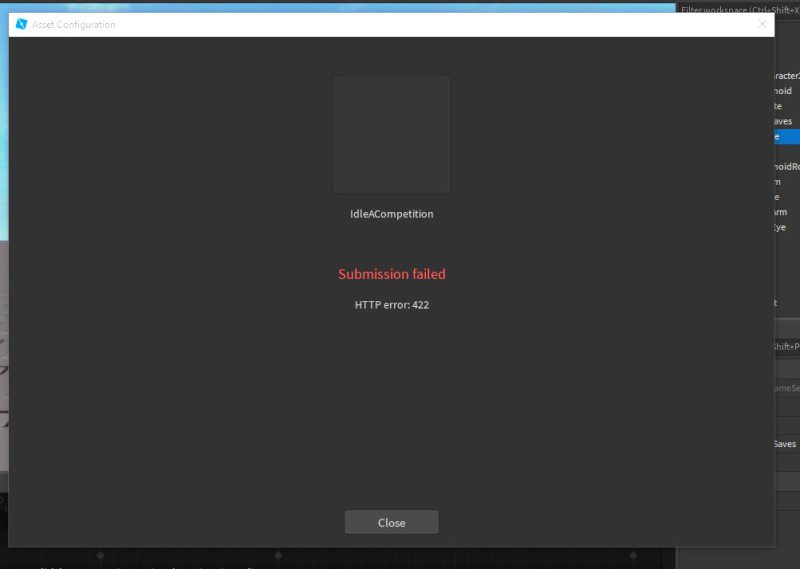The “422 Error” stands out as a particularly difficult conundrum in the vast forest of internet error messages, frequently leaving users and developers scratching their heads in confusion. The majority of digital terrains will inevitably contain errors. Understanding the underlying issues and identifying exact solutions, however, continue to be crucial. The “Unprocessable Entity” 422 Error typically means that a server comprehends the content type of a request entity and that the request entity’s syntax is correct, but that it was unable to process the contained instructions. What does this 422 Error mean, though, and how can we fix it?
Have you ever been desperately searching through the digital chaos for answers when the mysterious request failed with status code 422 Error suddenly and relentlessly grabbed you? 💻🚫 Imagine a world without this digital spectre interfering with any clicks, submissions, or interactions on your platform. 🌐✨ Welcome to your definitive resource, where we’ll help you solve the puzzles, analyze the nuances, and unlock the secrets so you can not only fight but also beat the request failed with status code 422 Error and protect your online experiences and transactions like never before!
🚀💼 Dive in as we make our way through the digital wilderness to make sure you defeat the infamous request failed with status code 422 Error and leave with a fortified digital domain, solutions, and strategies! Your path to mastering the digital world is being created right now; let the adventure begin! 🌟🗝️
1. Understanding the 422 Error
The WebDAV (Web Distributed Authoring and Versioning) protocol, an extension of HTTP that enables clients to perform remote web content authoring operations, is where the error 422 most frequently appears. Through the following filters, the request failed with status code 422 Error can be examined in more detail:
- Data Validity: The server cannot process the request because the data format is correct, but the semantic value or content is incorrect or malformatted.
- Syntactical Understanding: The server comprehends the syntax but cannot act on the instructions provided.
2. Causes Behind the 422 Error
A thorough understanding of the request failed with status code 422 Error potential causes is necessary for navigating through its mazes:
- A. Form Submission Issues
- Incomplete or improperly filled forms.
- Incorrect data types or unanticipated values.
- B. API Request Challenges
- Invalid parameters or incompatible data types.
- Validation problems in the request payload.
- C. Programming Oversights
- Misconfigured validations or incorrect rule sets.
- Neglecting to account for all possible input scenarios.
3. Solutions to Alleviate the 422 Error
A. Rigorous Data Validation
- Implement Thorough Client-side Validations:
- Ensure data types, lengths, and formats are verified before submission.
- Leverage JavaScript libraries for enhanced validation procedures.
- Construct Robust Server-side Validations:
- Develop a comprehensive validation schema for all incoming requests.
- Furnish useful error messages to aid in debugging and user correction.
B. Detailed API Documentation
The importance of having current, thorough, and accurate API documentation cannot be overstated.
- Clearly define acceptable parameters, data types, and formats.
- Include examples of correct API requests and responses.
C. Code Debugging and Testing
- Utilize automated testing tools to identify and mitigate possible requests with status code 422 Error triggers.
- Employ systematic debugging to uncover hidden issues and overlooked code segments.
4. Real-time Error Monitoring
By incorporating real-time error monitoring tools and techniques, the infrastructure can be strengthened against recurrent request failure with status code 422 Error occurrences.
- A. Employ Automated Monitoring Tools:
- Leverage software that alerts developers to issues in real time.
- Ensure monitoring tools cover API endpoints and data transactions.
- B. Establish a Log Management System:
- Implement log aggregators and managers to streamline error analysis.
- Configure alerts for anomalies and requests that fail with status code 422 Error occurrences.
5. Use Case Analysis: The “422 Error” in E-Commerce Platforms
The request failed with status code 422 Error appearance on e-commerce platforms can have negative effects on user experience and transactions.
- Scenario: A user attempts to purchase an item but is met with a request failed with status code 422 Error upon submitting payment information.
- Potential Causes:
- Payment data validation failure.
- API request format inconsistencies.
- Practical Solutions:
- Implement an exhaustive data validation mechanism on the client and server side.
- Construct detailed error messages to guide users towards resolution.
- Potential Causes:
6. User Education and Communication
Informing and directing end users becomes essential in the complex web of error resolution to ensure smooth interactions and reduce frustration during unanticipated hiccups like a request failing with status code 422 Error.
- A. Develop Intuitive User Guides:
- Craft guides that illuminate possible requests failed with status code 422 Error occurrences and straightforward resolutions.
- Utilize visuals and step-by-step instructions to enhance comprehensibility.
- B. Construct Informative Error Messages:
- Frame error messages that not only notify of the issue but also guide towards a solution.
- Include a direct link to relevant user guides or troubleshooting pages within the request failed with status code 422 Error message.
7. Developer Training and Knowledge Sharing
It is crucial to arm the development team with the knowledge and resources they need to manage and, more importantly, avoid the request failing with status code 422 Error.
- A. Continuous Training:
- Organize workshops focusing on the latest tools and techniques for request failed with status code 422 Error management.
- Encourage certifications and courses on proficient API development and data management.
- B. Foster a Knowledge-Sharing Environment:
- Establish platforms or channels for developers to share insights and learning.
- Facilitate regular knowledge-sharing sessions to discuss challenges and solutions.
8. Future-proofing Systems against the 422 Error
Systems must be prepared to manage and prevent errors with future technologies and methodologies as technological landscapes change.
- A. Adopt Emerging Technologies:
- Explore and integrate new technologies that enhance data validation and request failed with status code 422 Error handling.
- Implement AI and Machine Learning for smarter, automated error prevention and resolution.
- B. Ingrain a Proactive Approach to Error Management:
- Focus on preventing errors through meticulous planning, testing, and development.
- Involve Quality Assurance (QA) teams early in the development process.
9. Case Study: Navigating through the 422 Error in a Social Media App
Let’s examine a real-world social media application scenario to clarify our understanding:
- Scenario: Users attempting to update their profile pictures are confronted with a persistent request failed with status code 422 Error.
- Identifying the Root Cause:
- Initial analysis points towards an issue with image data processing.
- Further investigation reveals a discrepancy in acceptable image formats between client-side and server-side validations.
- Adopting a Solution:
- Align the acceptable image formats and data validations on both client and server sides.
- Update API documentation to communicate the acceptable image formats and sizes.
- Revise error messages to guide users in uploading compatible image formats.
- Identifying the Root Cause:
- Learning and Future Prevention:
- Post-resolution, cultivate learnings from the incident into the development and QA processes.
- Implement additional tests to ensure compatibility between client-side and server-side validations.
Conclusion
Despite appearing to be impenetrable, the request failed with status code 422 Error can be managed and mitigated by using a variety of strong validation mechanisms, thorough API documentation, and meticulous monitoring and testing systems. We can make sure that users have a seamless, error-free experience while using our platforms and protect them from potential pitfalls and disruptions by delving deeply into their root causes and generating tailored solutions.
Adopting a proactive, informed, and thorough approach to error management to navigate the vast and constantly changing digital landscape is not just advantageous—essential. it’s The solutions described here offer a strategic road map for not only fixing the request failed with status code 422 Error but also fortifying systems against it in advance, ensuring uninterrupted, seamless digital interactions for all users, at all times.
The complexity of the request failed with status code 422 error calls for a multifaceted strategy that not only concentrates on fixing the error in the instance but also aims to create reliable systems that prevent recurrences. We pave the way for developing a seamless, user-friendly digital experience by integrating exacting data validation, clear documentation, thorough developer training, and adopting cutting-edge technologies and methodologies.
Businesses and developers can promote a proactive environment that continuously seeks to improve and safeguard user interactions by realizing that error management is a journey rather than a destination. In the digital age, where the user experience is king, it is crucial to make sure that our systems are not only set up to handle errors but are also constantly protected against them.
People Also Ask (FAQ Section):
Q: What exactly is a 422 Error?
A: A request failed with status code 422 Error, technically known as “Unprocessable Entity”, emerges when a server comprehends the type and syntax of a requesting entity but is unable to process its contained instructions. This error typically surfaces in Web Distributed Authoring and Versioning (WebDAV) setups and reflects issues related to data validity, syntactical comprehension, or both.
Q: Why does the 422 Error predominantly appear in API and form submissions?
A: The request failed with status code 422 Error is often encountered during API interactions and form submissions due to data validation failures. It arises when the server is unable to process the provided data, despite it being in a correct syntax, due to semantic errors or misconfigurations in the sent instructions, such as incompatible data types, incorrect parameters, or validation discrepancies.
Q: How does the 422 Error impact user experience and digital platforms?
A: The appearance of a request failed with status code 422 Error can significantly impair user experience by interrupting smooth interactions and transactions on digital platforms. Users might encounter unexpected roadblocks during form submissions, payment processes, or while interacting with APIs, resulting in potential frustration, mistrust, and possibly, platform abandonment.
Q: Can the 422 Error affect the reputation and performance of an online business?
A: Absolutely! Consistent occurrences of the request failed with status code 422 Error can tarnish a platform’s reputation by disrupting user experiences and transactions. In e-commerce platforms, for instance, this error can prevent users from completing purchases, consequently affecting sales and customer satisfaction.
Q: How pivotal is accurate API documentation in preventing the 422 Error?
A: Immaculate API documentation is paramount in preventing the request from failing with status code 422 Error. Precise documentation provides clear guidelines regarding acceptable request parameters, data types, and formats, ensuring developers and API consumers send requests that align with server expectations, significantly minimizing the likelihood of triggering a request that failed with status code 422 Error.
Q: What role do client-side and server-side validation play in mitigating the 422 Error?
A: Robust client-side and server-side validations are crucial shields against the request failing with status code 422 Error. Implementing thorough validation mechanisms at both ends ensures that data is verified for correctness and completeness before it reaches the server, reducing instances of data incompatibility, and subsequently, minimizing the emergence of the error.
Q: Are real-time monitoring tools effective in managing the 422 Error?
A: Yes, employing real-time monitoring tools is highly effective in managing the request failed with status code 422 Error. These tools provide instant alerts to developers upon the error’s occurrence, enabling swift identification and rectification. Moreover, by maintaining a meticulous log, they help in analyzing error patterns and fortifying systems against future instances.
Q: How can user education contribute to minimizing the impact of the 422 Error?
A: Enlightening users about potential errors and offering guidance through intuitive user guides and informative error messages aids in minimizing frustration during an encounter with the request failed with status code 422 Error. By guiding users towards plausible self-resolution pathways and offering immediate assistance, platforms can mitigate the adverse impacts and ensure sustained user engagement.
Q: What preventive measures can be adopted to safeguard against future 422 Error occurrences?
A: Preventing future instances of the request failing with status code 422 Error involves a blend of rigorous data validation, detailed API documentation, meticulous developer training, continuous code testing, and leveraging emerging technologies like AI for smarter, automated error handling. Establishing a proactive, error-preventive culture ensures that systems are perpetually fortified against errors, guaranteeing seamless user interactions.
Q: Can the solutions for the 422 Error be adapted for other HTTP errors as well?
A: While certain strategies like comprehensive data validation, user education, and real-time error monitoring can be adapted to manage other HTTP errors, it’s imperative to recognize that each error code has its unique characteristics and causes. A tailored approach, considering the specific nuances of each error type, is essential for effective management and resolution.









![[LISTS] Best Chat GPT App for iPhone – Can You Handle the Suspense? Best Chat GPT App for iPhone](https://www.techinpost.com/wp-content/uploads/Best-Chat-GPT-App-for-iPhone-324x235.png)

